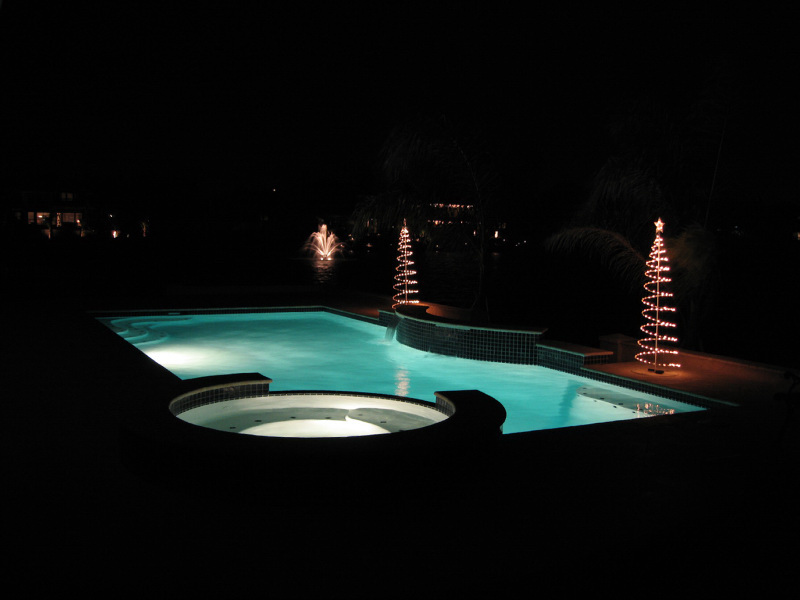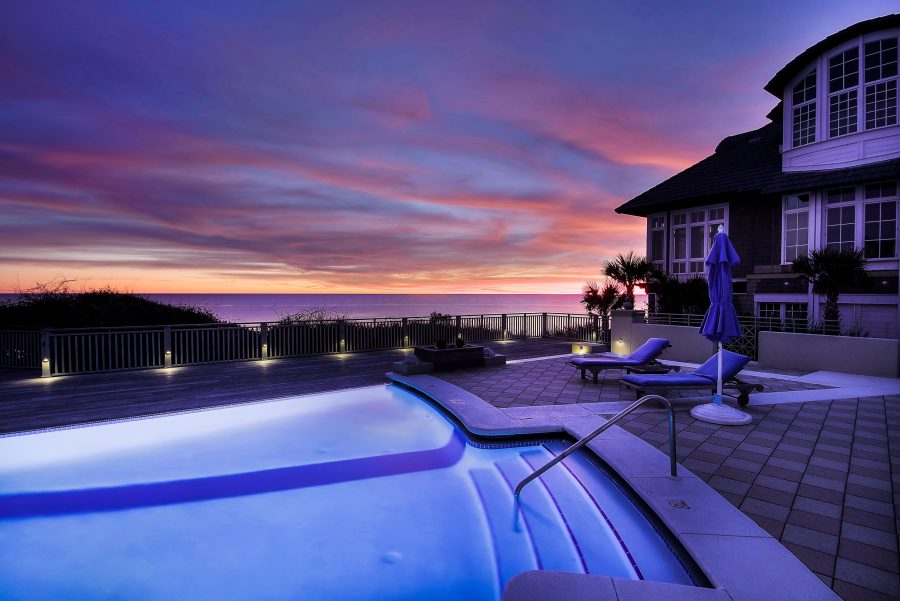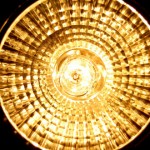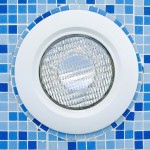You’ve had your swimming pool for a while now and you need to upgrade your old pool lights. You know that LED lights are the wave of the future, and they certainly look great on your holiday decorations! But before you automatically leap to embrace the LED option, consider all of your choices and the potential downside to LED swimming pool lights.

Article Contents
First a Refresher on Pool Lighting Options
Make no mistake: not having swimming pool lights is no option at all. You want to swim at night, don’t you? Obviously the safety of your children while they swim at dusk is of paramount concern! And you’ve seen enough pools to know that a well-lit swimming pool is a wonder to behold.

So where to begin? First, understand that there are three popular choices:

1. Classic and traditional halogen lighting, that you’ve seen in the bottom of every pool since the mid-20th century. Reliable but boring, and certainly the cheapest option, halogen lighting is also vulnerable to corrosion damage and also needs regular yearly maintenance.

2. Fibre optic lighting. You can certainly make your pool glorious and glamorous with fiber optics – but you’ll pay a similarly out-of-this-world price for initial installation. You’ll also pay each month when the electric bill comes due! In addition, it should be noted that fibre optic pool lighting is not currently very popular in Australia. Because it is less popular, you may have some difficulty finding a contractor to install this option – and you may find greater costs associated with initial installation and later maintenance.

3. LED pool lights. LED provides brilliant, clean light, in myriad colors. More expensive than halogen lighting but is much cheapers than installing fiber optic pool lights and can be easily used in place of your old halogen light. Best of all, LED pool lighting – like all LED lighting – is enormously energy efficient, lighting your pool for a fraction of the cost of other options.
What Exactly is “LED” Lighting?
At this point, you’re wondering how exactly we could suggest that there might be some issues with these energy-efficient, cheap to operate, highly functional and perfectly safe pool lights, aren’t you? Before we get to that, a quick explanation of what an LED light really is!
LED stands for “light emitting diode,” and it works by pumping voltage through a semi-conductor which emits light. Where traditional incandescent & halogen lighting relies on burning filaments, and fiber optics require extensive and complex cable-laying, LED’s work simply – plug them into a power source. They use very little energy per LED compared with other methods of pool lighting, produce almost no heat, boast extended usable lifetimes, and are environmentally conscious. So what’s not to love?
Problems with LED Pool Lights: The Unfortunate Dark Side of the LED Option
Sounds good, doesn’t it? Slash your electric bill in half, have lights that last just about forever, and give your family an option that combines form with function.
But LED pool lights are far from perfect, and before you invest in a new and expensive LED pool lighting system (especially if you’re pondering ripping out your boring old – but very trustworthy and reliable – original halogen system), you need to be fully aware of all the drawbacks to LED pool lighting. These include 7 specific issues:
1: Do LED Lights Really Last 80,000 Hours as Promised?
All the marketing hype would have you believe that your new LED light will last for 50,000 to 100,000 hours (up to 12 years). This is a half-truth really.
Yes the LEDs themselves will normally last that long. What you aren’t normally told is that the other components in the light probably won’t last anywhere near that long.
2: Big $$$$$ – Part 1
Did we mention cost? The initial installation for LED pool lights will be a minimum of 2-3 times what traditional lighting costs. Of course, you may recoup some of that initial cost with lower energy bills.
3: Transformer Troubles
First, LED lighting – just like the lower tech halogen option – must be run through specific transformers and convertors in order to utilize the proper voltage that falls between 12v and 32v.
These additional and required pieces of electronic gear add to the cost, and they also add a singular but troubling vulnerability to the system: when the transformer blows, the LED pool lights wink out. Fortunately, transformers are fairly reliable and not too expensive to replace.
4: Plug the Leak
Yes, just like halogen lighting, LED lights for your pool can leak! Unfortunately, many of the diodes at the core of LED lighting are susceptible to varying degrees to leakage of water.
Obviously, this can be a bit of sticky wicket when you’re trying to light a pool! Fortunately, technology has largely solved this issue with the advent of resin-filled LED lights. Thus, if your current LED pool lights leak, individual lights can be replaced with the resin-filled version.
5: Nothing Lasts Forever
Unfortunately, LED lights do degrade over time! While you can probably rest assured that you’ll recoup your investment relatively quickly in energy savings, it is scientific fact that LED lights eventually lose their luster – and will require potentially complete replacement of the system!
Traditional pool lights may not be as attractive, but barring corrosion issues they can sit at the pool bottom for decades without issue.
6: Beware the Passing Fad
Are they the wave of the future? Remember, you’re building your pool for your children’s children. They may own that home one day, and the pool that comes with it. Some experts suggest that LED pool lighting is akin to music CDs – sort of an intermediate step between classic vinyl and modern digital music. In other words, the classic look will always be an option, and other futuristic choices (like fibre optics) may be the next big thing.
I personally beleive LED lighting is the way of the future. The entire lighting industry (not just lights for pools) is swapping their lights in favour of LED.
7: Big $$$$$ – Part 2
Lastly, as mentioned above, although the LEDs may last years, if the other components of the light fail, then you may be regretting your choice! In most cases, the lights themselves are not serviceable and will have to be replaced. You’ll need to fork out for the cost of a new light as well as someone to install it.
In Summary
Please don’t think we are trying to talk you out of LED pool lighting. It is a beautiful, efficient, and cost-effective option to create a perfectly illuminated pool. But before you take that next step, go through all the pros and cons. Decide what pool lighting is best for you and your family.
Then jump right in!
Related Reading: Cost to Install an LED Pool Light
Recommended Products
Photo Credits: Teaser Photo Attribution: By Bill Jacobus ; Blog Photo Attribution: By Bill Jacobus ; Blog Photo Attribution: By Pete ; Blog Photo Attribution: By Bill Burris


My PAL 2 lights quit working. I replaced the transformer. The lights com on but go dark after a few mins. Could this be the bulbs?
I cannot get the bulb back in the hole. The long tube goes in so far, water squirts our and will go no further.
Help
my pool light is acting very strange. When I turn it on it is very dim but after 5 or 10 minutes it’s nice and bright. Is this a problem with the transformer needing to warm up or is it more likely a problem with the pool light itself?
It’s hard to say. It’s unlikely to be the transformer. However, the transformer is the easiest thing to swap when diagnosing pool lights that don’t work. So you may consider changing it just to rule it out.
My LED (Lau-2) lights up blue and if I turn off and on again to get the colour change nothing happens. I can turn off and on again and the blue works again.
Any ideas why the colour change feature is not working
Sounds like something is wrong with the internal circuit of the light. It’s likely the only solution is to replace it as repairs are probably not worth it.
Hi Adrian,
We installed a pool early this year , we have notice the light in pool goes green and switches off , what would the reason for this?
We installed a pool with LED lights just over a year ago. We noticed that there was a glow from the lights, even though we hadn’t turned them on. After a few months they stopped work. The transformer was replaced. But there is still a glow. Why are the lights using power and glowing? And will the transformer stop working again?
Thanks
It’s hard to say why your LED light isn’t working properly. Sounds like there is an issue with the wiring between the light and the switch and the switch and the transformer. Or perhaps a grounding issue. You’ll need a pool professional to check it out.
We recently bought a 17 year old home with a pool and spa with the classic halogen lighting. A couple months in, the pool light was tripping the breaker and needed to be changed. Our local pool professional made the switch but I wasn’t fully aware that it would be led.
I really really really don’t like led lighting (anywhere)! I wish the pool had the charming and soft glow that is still in the spa.
Can anything be done to the pool led light to make it more softer and look more like the softer yellow glow of a halogen?
LED pool lights come in different color temperatures and with different diffusers. It’s the diffuser or lack of which will determine if the light is soft or hard (harsh shadows). The color temperature is the color of the light. A warm yellowish light is around 3000 kelvins(K) whereas white light is around 5000K. You may want to investigate swapping the light.
My LED pool light has all of a sudden started flickering and does not light up the pool very much, the pool is only about 6 years old so the bulb is not that old. Would this be the transformer/
It’s hard to say exactly. It could be a bad connection somewhere, the wiring between the light and the power source, the transformer or the light itself. It’s most likely your pool light though. Although the LEDs themselves are good for many thousands of hours, the driver or electronics will fail much sooner.
If it happens regularly, you could put a multimeter where the pool light is connected and check the voltage is constant. If it’s not, it’s an issue between the end of the wires at the light and the transformer. You can trace it back from there. Other than that, the only real way to know is to start swapping components for known good ones.
I had both pool lights on, and then one just dropped out. They were out of sync prior to dropping out so. What is the best way to resync them so both project the same light, and secondly i assume a connection or bulb has gone if only 1 is now working ? Pool is 2 years old.
Start with the simple things first. Try swapping the bulbs from the pool light that is working to the other one and see if that fixes it. If it does then you know changing the bulb will fix the pool light. If that doesn’t work, then you need to measure the voltage on the light that’s not working. If there’s no voltage, then you’ll need to trace it back from there and find the issue. It could be the transformer or it could be the wiring between the transformer and the light.
My power box doesn’t turn on and the fiber optic lens leaked and filled with water where algae is insincerity’s behind the lens . What’s the best replacement or cost effective way to try an restore it?
I have 2 light in the pool controlled by one switch. One comes on right away and the other takes about a minute to turn on. They both used to turn on instantly with the switch.
Any idea of what is causing the delay?
Could be the pool light. Try swapping them and see what happens. If the problem swaps around, you’ll know the pool light is not working.
My multi color light works but lately rather than 20 seconds between color changes it is now closer to 7 seconds. Is it the bulb ??? Is the something above water that determines how quickly the light colors change ???
My pool light comes on but it is very dim .
This could be caused by a couple of different reasons. A dim pool light could mean that the voltage to your light is low. This would fault would normally be for low voltage powered pool lights not mains powered pool lights. I would suggest you test this with a voltmeter and compare to what it’s supposed to be. If it is low try replacing the transformer or power supply. For LED lights, it could also be the light itself by not that likely. If it’s a mains powered pool light, leave this to the professionals as it can be dangerous.
One of our Spaelectric LED lights does not work and the other is dim. Pool is just under 8 years old. I’m thinking the transformer is in need of replacement.
It’s hard to say. You need to remove the light that doesn’t work and use a multimeter to test if you’re getting any voltage there. If you have voltage it’s likely the light that is the problem. However, if it’s easy to change, you could change the transformer first to see if that fixes it since it’s relatively inexpensive.
I find the pal colourchange light a bit of overkill. I am not interested in party colours, just a nice white glow to be able to swim safely and se if there are any snakes in the pool. Is there a white lamp available? Or can I use any two wire white led lamp? Thank you
Hi , My LED pool light has gone dimmer and doesn’t change colors anymore. The voltage is still 13 volts going to it. Any ideas?
thx
most likely drivers or other component on PCB inside light fixture. unfortunately most pool/spa lights are not repairable. Alas a new light fix will need to be installed. Cost will depend on light used & length of run to transformer or switch.